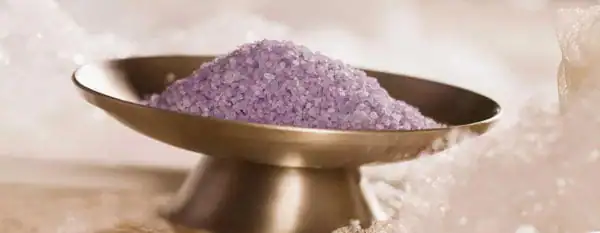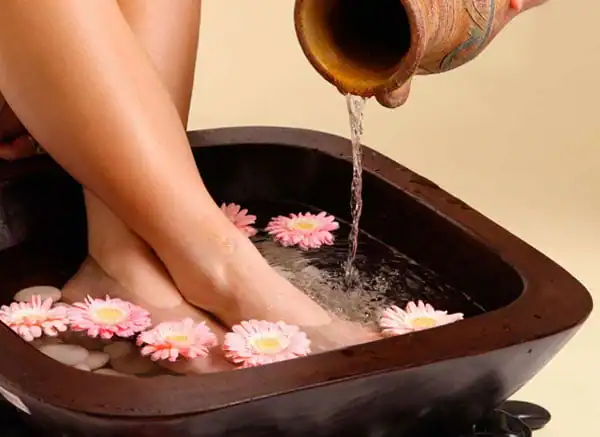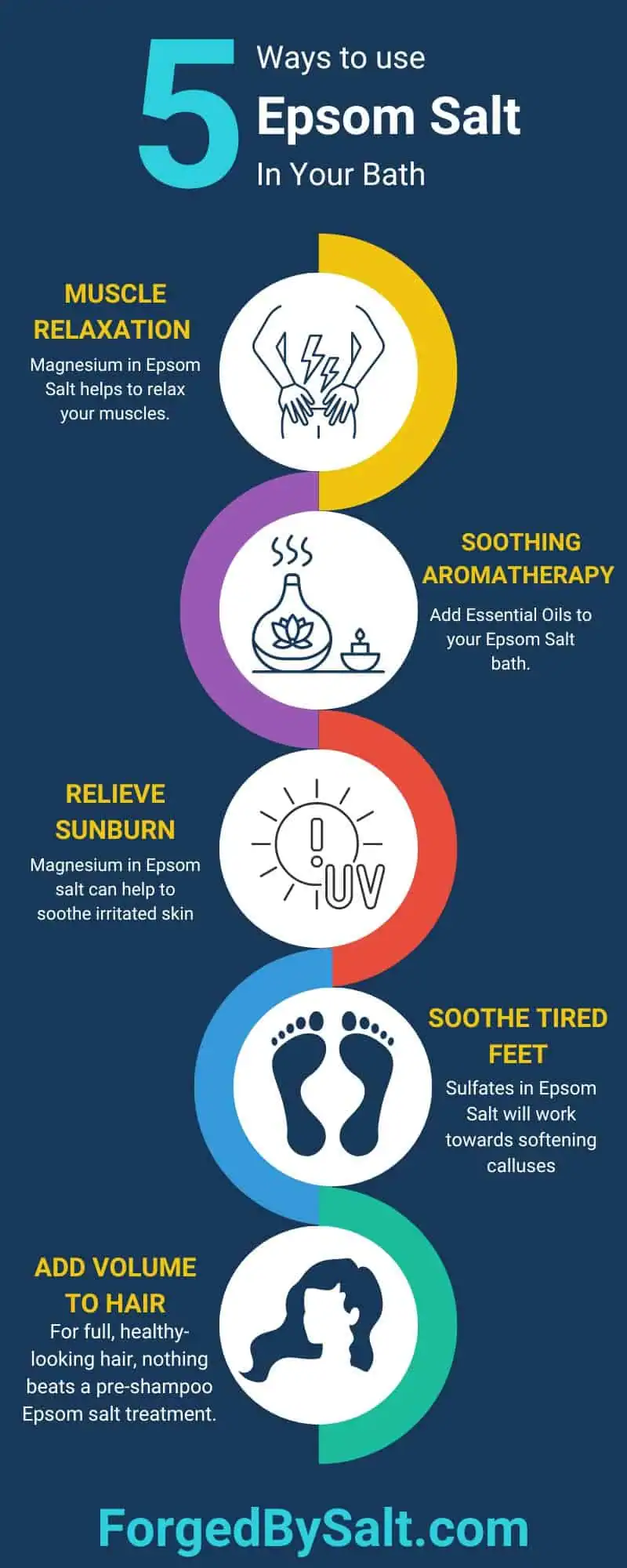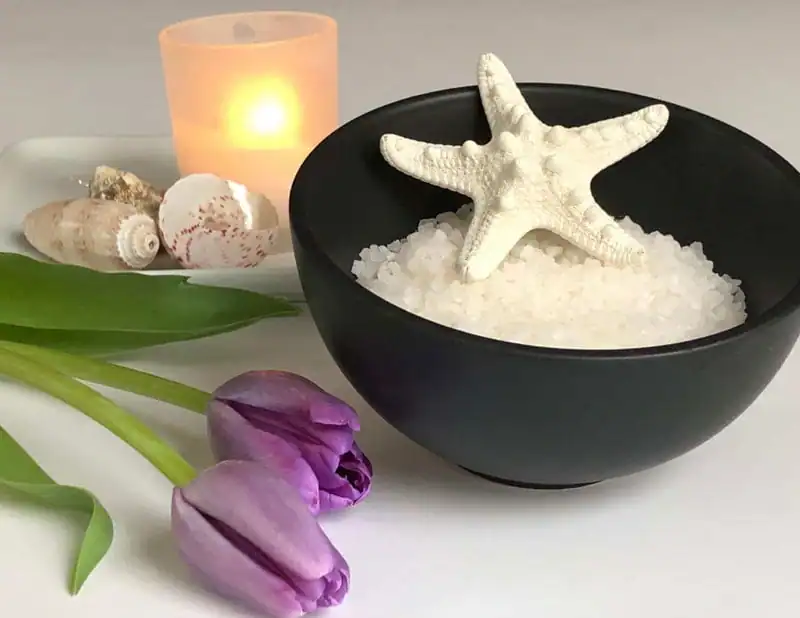Epsom salt has been used for centuries for its many health and wellness benefits. This versatile mineral salt, made up of magnesium and sulfate, can be easily absorbed through the skin and can help to relax the muscles, reduce inflammation, and remove toxins from the body when used in an Epsom salt bath.
Many health and fitness professionals, including doctors, chiropractors, sport medicine practitioners, trainers and massage therapists recommend Epsom salt baths for relief of tired, strained or over-worked muscles. But what exactly does that mean? How much Epsom salt should you use? Should you use a different amount depending on what you are trying to achieve? Is there such a thing as too much Epsom salt?
In this article, I’ll start with giving you a way to figure out how much Epsom salt you should be using for your bath or soaking setup. Then I will explore 9 Epsom salt bath ideas or purposes.
How Much Epsom Salt?
There are lots of online articles and package instructions that say “use 1 to 2 cups” of Epsom salt, but how do they know how big your tub is? What if you have one of those huge soaking tubs (lucky you!) or one of those small, but very convenient walk-in tubs where you get to sit on seat (lucky you!). But the reality is that most of us have smaller, not very deep tubs that are often multi-purposed as a basin for collecting the shower water. Here are some salt bath instructions that are dialed in for the size of tub you plan to use.
How Many Gallons in Your Tub?
The amount of Epsom salt you should use corresponds with how much water you are going to put in your tub. Assuming that you’d like the water to be deep as possible, here are some tips for figuring out how many gallons of water you have in a tub full.
- Tub manufacturers tell you how much water will fit in your tub. Realistically though, who holds onto that information or even knows what model number of tub is in your bathroom? Not many. Not me.
- AVERAGE tub sizes in US households tend to be between 40 and 80 gallons. So if you have a very small tub, you might want to use 1 cup of Epsom salt and if you have a very large tub, perhaps you want 2 cups of Epsom salt.
- I also found this really detailed article that describes all kinds of different tub configurations (corner tubs, clawfoot tubs, etc.) with tables showing typical gallon sizes: Tub Capacity.
Or You Can Do the Math …
It actually is fairly simple to get a rough estimate of how much water fits in your tub when you know “the magic number”. First you need to get some approximate measurements from your tub – we are measuring in INCHES for this exercise:
- Measure the Length – Since tubs tend to be sloped, take a measurement about halfway between the bottom of the tub and the bottom of the overflow.
- Measure the Width – Same rules as above: measure at the halfway mark. If your tub is a lot wider in the center than at the ends, measure the width at a spot about halfway between one end and the middle.
- Measure the Depth – Measure from the bottom of the tub to the bottom of the overflow.
Drumroll! Here comes the magic number:
Height (inches) x Width (inches) x Depth (inches) x 0.00433 = Gallons
Real Life Example: I have a very average ordinary tub. It is 53″ long, 23″ wide, and 9″ deep. So my tub holds a maximum of 47.5 gallons, approximately.
Apologies to Europeans and all those who live in countries who sanely use the metric system. Here is your formula:
Height (cm) x Width (cm) x Depth (cm) x 0.001 = Liters
Real Life Metric Example: I have a very average ordinary tub by US standard. It is 135cm long, 58cm wide, and 23cm deep. So my tub holds a maximum of 180 liters, approximately.
So now, How Much Epsom Salt to Use?
The proportion of Epsom salt to water for muscle relaxation is about 1 cup (8 ounces) per 40 gallons of water. Sometimes it is easier to see it in a table:
| Bathtub Size | Epsom Salt |
| 40 gallons | 8 ounces (1 cup) |
| 50 gallons | 10 ounces (1 1/4 cups) |
| 60 gallons | 12 ounces (1 1/2 cups) |
| 70 gallons | 14 ounces (1 3/4 cups) |
| 80 gallons | 16 ounces (2 cups) |
| 100 gallons | 20 ounces (2 1/2 cups) |
| 120 gallons | 24 ounces (3 cups) |
Metric system users, your life is simple, as usual. This same concentration of Epsom salt is about 16 grams per liter of water.
How Much Epsom Salt is Too Much?
Epsom salt for soaking is generally considered very safe. Reports of Epsom salt toxicity are for people who ingest Epsom salt, not for people who use it in a bath. That being said, more is not necessarily better, so you don’t want to use too much Epsom salt. These are the things to look out for:
- Dry, itchy skin after soaking
- Allergic reactions or inflammation
- Adding so much Epsom salt to the bath water that it get slippery – careful getting out of the tub!
In general, if you are trying to treat severe muscle aches and tightness, you safely could double the amounts of Epsom salt mentioned in this article, but I don’t recommend using more than that, unless directed by a physician.
Note that Epsom salt baths are not recommended for people with diabetes – if this is you, be sure to check with your doctor for proper medical advice before using Epsom salt for bathing or soaking.
Muscle Relaxation and Stress Relief
One of the most popular ways to use Epsom salt is by adding it to a warm bath for muscle relaxation and stress relief. Epsom salt is made up of magnesium and sulfate, which can be easily absorbed through the skin to help soothe sore muscles and ease tension.
When you soak in an Epsom salt bath, the magnesium helps to relax your muscles and reduce inflammation, while the sulfates work to flush toxins out of your body. This can leave you feeling refreshed and rejuvenated. The warm water will help to open up your pores, allowing the magnesium and sulfates to be easily absorbed into your skin. After the bath, you will likely feel more relaxed and less stressed, and your muscles will feel less sore.
Epsom salt baths are also a great way to unwind after a long day or a hard workout. The minerals in the salt can help to ease tension and soreness in your muscles, leaving you feeling refreshed and rejuvenated. Just follow the water to Epsom salt proportions listed above for muscle relaxation and enjoy your Epsom salt bath!

Soothing Aromatherapy Bath
Essential oils are known for their ability to promote relaxation and reduce stress, making them the perfect addition to an Epsom salt bath. Some popular essential oils to use in an Epsom salt bath include lavender, peppermint, eucalyptus, and chamomile. Each of these oils has its own unique properties that can help to soothe the mind and body.
- Lavender – Lavender oil is known for its calming and soothing properties, which can help to reduce stress and anxiety.
- Peppermint – Peppermint oil is known to have energizing properties that can help to invigorate the mind and body.
- Eucalyptus – Eucalyptus oil has a cooling effect on the body, making it ideal for easing soreness and tension.
- Chamomile – Chamomile oil is known for its calming properties that can help to promote relaxation.
To enjoy the therapeutic benefits of a relaxing Epsom salt bath enhanced with essential oils, add the recommended quantity of Epsom salt above to warm water. Miix in your preferred essential oil at a rate of about 1 drop per 20 gallons of water. The soothing heat will assist your body’s pores to open, enabling magnesium and sulfates from the Epsom salt to be absorbed into the skin. At the same time, these fragrant essential oils are diffused through air molecules creating an atmosphere that is both tranquilizing and calming.
There are many many products on the market that have fragrance already added to the Epsom salt, but it usually increases the price and you often don’t know what ingredient(s) was used as the fragrance. If you have your own essential oils, or if you know you can be sensitive to ingredients that are commonly used as fragrances, it is nice peace of mind to add your own oils. That being said, if you don’t have sensitive skin, there are some very nice aromatic Epsom salt products on the market when you’d like to enjoy a little splurge!
Some of the top-rated Epsom salt + fun stuff is not even splurgy – running less than $2 per pound at the time of writing this article. Check out this combination, for example:
Pure Epsom salts from Dr. Teals - this soaking solution adds Arnica, Menthol and Eucalyptus essential oil for a solution to sooth body aches. The package supplies 48 ounces (3 pounds) of product - enough for many soaks.
In the “slightly more splurgy, but still reasonable” category is this combination that I liked because it also adds some pink Himalayan salt in the mix:
This aromatic bath salt blend incorporates pink Himalayan salt with the main ingredient of Epsom salt. Lavender essential oil is also used. Do note that while this soaking solution does say "No artificial dyes or additives", the picture is rather purple colored so take care if you are someone that is sensitive to perfumes or dyes. This package contains 2 pounds (32 ounces) of bath salt blend.
Relieve Soreness and Pain From a Sunburn
Another use for Epsom salt is to help relieve soreness and pain from sunburn. Sunburn can cause skin irritation, redness, and pain, which can be relieved by adding Epsom salt to a cool bath. The magnesium in the Epsom salt can help to soothe and calm irritated skin, while the sulfates can help to reduce inflammation and redness.
To use Epsom salt for sunburn, add about half the recommended amount of Epsom salt to a cool bath and soak for 20 minutes. If your sunburn tolerates the half concentration of salt, you might possibly add a little more while you are in the tub, but don’t go overboard.
It’s important to note that soaking in a cool bath with Epsom salt can also help to bring down the skin’s temperature and prevent further damage from sun exposure. It also helps to moisturize the skin, which can be especially important after sunburn, as sunburned skin can become dry and flaky.
Some people also report that cool Epsom salt baths can relieve the itch caused by Poison Ivy. Fortunately, I have not personally been able to test this remedy.
Ease The Symptoms of Eczema
In addition to its many other benefits, Epsom salt can be utilized to alleviate the signs of eczema or any other skin conditions. Eczema is a common skin affliction that leaves one with itchy and inflamed skin surfaces.
The magnesium element found in Epsom salt works wonders by hydrating the affected areas while simultaneously reducing inflammation; sulfates are especially useful at purging harmful toxins from your epidermis as well!
To find relief from eczema, it is a good idea to use half the recommended amount of Epsom salt (above) on the first time you try this. If your skin tolerates (and appreciates) the bath salt, you can increase the quantity of Epsom salt the next time. Add Epsom salt to warm bath water and soak for 20 minutes. Chamomile essential oil is also beneficial in treating inflammation and soothing itchy skin. I would also recommend it at half the recommended rate until you evaluate how your skin feels.
It’s important to remember that after bathing, patting the skin dry and applying a moisturizer or cream is essential for locking in moisture and preventing further dryness. Additionally, it’s best to steer clear of water that is too hot as this can be particularly irritating for eczema-prone skin.

Soothe Tired Feet and Soften Calluses
After a tiring day, treat yourself to an Epsom salt foot soak that is sure to relieve stress and discomfort. The combination of magnesium in the salt will help relax muscles while reducing inflammation, while sulfates work towards softening calluses and exfoliating dead skin cells. Not only will you feel rejuvenated but also have softer feet!
While you can soak your feet in any container that has room for your feet and is deep enough, there are many convenient foot bath containers on the market. Some are even collapsible, for those of us that need to conserve storage space. These foot baths tend to hold about 4-5 gallons of water or around 15 liters. Another idea, if you don’t want to invest in a purpose-made foot bath, is to use a camping cooler. Coolers are sturdy and insulated, and they usually have good handles, so they really make nice foot soaking containers.
For a revitalizing foot soak, I suggest a stronger concentration of Epsom salt than for a bath. I like to use about 1 tablespoon of Epsom salt per gallon of very warm water. Submerge your feet for 20-30 minutes or until the water is tepid. Adding several drops of peppermint essential oil to the bath can help reinvigorate tired feet while providing an pleasant scent. Make sure you dry off and then treat your feet with some moisturizer!
Cool Summer Idea: Even though I usually suggest using very warm water (as I did above), in the height of summer I like to use just barely lukewarm water for a foot soak. The temperature is pleasant when you insert your feet, but the overall result seems to help reduce body temperature, so this is cooling (but not chilling).
Foot Health Ideas: To get targeted suggestions about how Epsom salt can be used to help relieve specific foot related ailments, see our articles on athlete’s foot and toenail fungus.

Detoxifying Bath
Using both Epsom salt and baking soda is an unbeatable way to use this extraordinary mineral for a soothing bath. Together these two ingredients make up a potent detoxifying bath that cleanses and invigorates the skin. What benefits do they each bring to your bath?
- Baking Soda – has the power to counterbalance acids and adjust the skin’s pH level
- Epsom Salt – can ease muscles, reduce inflammation and expel toxins
To create a blissful and soothing bath, simply combine 1/2 cup of baking soda for every 1 cup of Epsom salt that you use to warm water. Relax in this luxurious concoction for 20-30 minutes while your body absorbs the benefits of these natural ingredients. To further sweeten the experience add some drops of essential oil you love!
When it comes to detoxing your body, taking a bath is an effective method. To maximize the benefits of this process though, remember that water intake (drinking your water) before and after the bath plays a crucial role in flushing out any impurities from your system.

Reduce Swelling and Inflammation
Treat yourself to a relaxing Epsom salt bath, and help reduce swelling as well as inflammation in your body. Although some amount of inflammation is part of the natural healing process for any injury or infection, chronic inflammation can lead to several health problems.
Luckily, Epsom salt has many beneficial properties that can combat this issue. The magnesium helps block pro-inflammatory molecules from being produced while the sulfates increase nutrient absorption and flush out toxins from your system!
To soothe inflammation and reduce swelling, simply add Epsom salt to your warm bath water at the rate suggested above. For an extra boost, incorporate a few drops of ginger essential oil which is known for its anti-inflammatory properties and circulation-enhancing compounds into the mix before soaking in it for 20 minutes.
By taking an Epsom salt bath, you will quickly notice a decrease in swelling and inflammation as well as feel incredibly relaxed and invigorated. This can also help to induce quality sleep allowing your body to recuperate from chronic inflammation.

Add Volume To Hair
For full, healthy-looking hair, nothing beats a pre-shampoo Epsom salt treatment. The natural exfoliation of this mineral helps to eradicate any dulling build-up from products or hard water deposits and adds life back into your locks. Furthermore, the magnesium content in Epsom salt strengthens hair for improved health. Revitalize and protect your mane with an invigorating Epsom salt cleanse!
Pre-Shampoo Rinse
For a pre-shampoo treatment, dissolve 2 tablespoons of Epsom salt in 1 gallon of warm water and stir until evenly mixed.
Soak your hair with the solution by pouring it over your scalp and massaging gently for a few minutes. You can also comb it gently through your wet hair using a wide tooth comb or hair pick. Go slowly and be gentle! Then rinse off thoroughly with warm water.
After the treatment, you can shampoo and condition your hair as usual. You may notice that your hair feels cleaner, softer, and has more volume. Epsom salt can also help to create natural beachy waves, by scrunching the hair while it’s damp after the treatment.
Bear in mind that Epsom salt may cause dryness to the hair if used too regularly or at high concentrations. Therefore, it’s important to be aware of any potential sensitivity toward this product before using it. For optimal results and hydrated locks, use no more than once a week and follow up with a deep conditioning treatment.
Salt Hair Spray
I love this one! My hair (very thin, somewhat curly) responds really well to homemade Epsom Salt Spray. I wrote an entire article about it! Sea Salt Spray: Texture Your Hair!
Improve Sleep and Promote Relaxation
By adding a bit of Epsom salt to your bath, you can find yourself drifting off into a deep and peaceful sleep. For starters, the magnesium found in this mineral helps relax tense muscles as well as reduce inflammation. Additionally, sulfates present in this salt assist with nutrient absorption while simultaneously flushing out toxins from the body for an overall rejuvenating experience!
There are scientific studies that indicate that having proper levels of magnesium may promote better sleep. While transdermal absorption of magnesium is less than what you might obtain from oral supplements, a warm bath in Epsom salt enhanced water certainly can’t hurt. For more on the impact of magnesium on sleep, you might be interested in this article Magnesium for sleep from the Mayo clinic.
For a night of restful sleep, add Epsom salt at the suggested rate mentioned above to your bath and soak in it for 20-30 minutes before you go to bed, but be sure not to nod off in the bath! To make the experience even more calming, add several drops of lavender essential oil to your warm water. This mixture will help lull you off to dreamland so that when morning comes around again, you’re ready!
Frequently Asked Questions
Does Epsom Salt Expire?
Did you ever wonder if Epsom Salt expires or goes bad? Since Epsom salt is a naturally occurring mineral salt – magnesium sulfate – it doesn’t ever really expire. Some packages of Epsom salt may come with a “best used date”, but it more likely refers to other added ingredients such as essential oils or perfumes.
Epsom salt that has been sitting around for a while may get solidified or clumpy, but it still work fine in a bath and will dissolve. Since most salts tend to act as desiccants (the tendency to absorb moisture), it is possible that the aroma might change a bit or smell stale, but once again it shouldn’t affect the usefulness of the elements in the salt.
How long should I soak in an Epsom salt bath?
A common length of time for an Epsom salt soak is 15 to 20 minutes. You can certainly stay in the Epsom salt solution longer, but usually the water starts to cool off and soaking is not as pleasant.
The benefits of magnesium absorption will occur within this period of time. People who experience any skin discomfort should use a shorter time period, rinse with clear water after getting out of the Epsom salt bath, or avoid Epsom salt altogether. Fortunately, reactions to Epsom salt is fairly rare.
How often can I take an Epsom salt bath?
Twice to three times a week is a typical frequency for people seeking self care from Epsom salt soaking. Your health professional may suggest nightly soaks if you are trying to treat certain symptoms like muscle spasms – be sure to follow any medical guidance you receive.
People with underlying issues like kidney disease or heart conditions should consult with their medical professional first to determine both frequency and how often Epsom salt should be used.
Can Epsom salt baths cause dehydration?
Yes – if Epsom salt soaks are over used, it is possible to cause dehydration. Also, if the Epsom salt is too concentrated it can contribute to dehydration.
Be sure to follow the guidelines above for how much Epsom salt to use for the size of your tub. It’s also good to drink water before and after a soak.
Can pregnant women use Epsom salt baths?
Generally yes, Epsom salt is safe for soaks during pregnancy. Be sure to check with your health provider first – both to confirm it’s safe for you and your child, but also to let them know about it if they want to note it on your medical chart.
Can children use Epsom salt in their baths?
Generally yes, Epsom salt is safe for children’s bathing. Be sure to check with your pediatrician first to confirm that they concur. In children’s baths, parents tend to use about half as much Epsom salt as they would for themselves. Be sure to always supervise your child’s bath, whether it contains Epsom salt or not. Epsom salt can make the tub surface slightly more slippery, so take care entering and getting out of the water.
Can Epsom salt help with sore muscles or after workouts?
Yes! Many physically active individuals rave about the benefits of Epsom salt soaks for post-workout recovery and general muscle relaxation.
Looking for Epsom Salt gift ideas? Be sure to take a look through our list at A Gift of Salt: Gift Ideas for People Who Have Everything.









